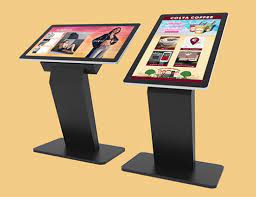Touch Screens are popular tools used for user engagement. These screens are extensively used for various devices to enhance user experience and improve business prospects.
There are
several touch panel technologies available in the market. The resistive touch
panel, surface capacitive touch panel, projected capacitive touch panel,
surface acoustic wave touch panel, infrared touch panel are a few touch panel
technologies available in the market.
The most
popular technologies used are the resistive touch panel and the capacitive
touch panel.
Resistive
touchscreens are made of two layers. Touching the top layer makes contact with
the bottom layer, completing the circuit and creating a current loop. Resistive
touch screens are less expensive to manufacture and integrate into the program
responding to all types of touch functionalities.
Capacitive
touchscreens are made up of two layers a surface insulator and a transparent
conductive layer beneath it. The electrostatic field of the touch panel is
distorted when it is touched with the finger or a conductive pen.
Which one is better? Resistive or Capacitive?
Capacitive
touchscreens are preferred over resistive touchscreens for the following
reasons:
Capacitive
touchscreens give more contrast and clarity on the screen unlike resistive
touchscreen which have more reflections due to their layer count.
Capacitive
touch is significantly more sensitive.
Capacitive
touch is capable of multi-touch points.
Resistive
touchscreens are cost-effective when compared to capacitive touchscreens.
Resistive
touchscreens consume less energy when compared to capacitive touch screens.
The touch
resolution in resistive touchscreens is higher than that in a capacitive
touchscreen.
The touch
durability in resistive touchscreens is 3H, and has the risk of easy scratch.
Capacitive touch screens have a touch durability of as high as 9H and are hard
to scratch.
Resistive
touchscreens are easy to manufacture whereas capacitive touchscreens require
high-level precision.
Capacitive
touch screens support a lot of gestures like zoom in and zoom out, scroll,
swipe, drag, slide, hold/press, rotate, tap, etc.
Capacitive
touchscreens are easy to clean of dust, grease, moisture, etc.
Capacitive
touchscreens are more preferred over resistive touchscreens as they are
improvised with sensors that allow using them with heavy-duty gloves.
While both
resistive and capacitive touchscreens are unique in their functionality, it is
best to choose the one that best suits one’s requirement.
VRS
Technologies offers the latest Touch Screen Rental Dubai for organizing the
most engaging events.
We offer
interactive Touch screen kiosks, multi-touch screens, and LED Touch screens.
Our range of touch screens is compatible with USB devices or SD cards to
display content.





No comments:
Post a Comment